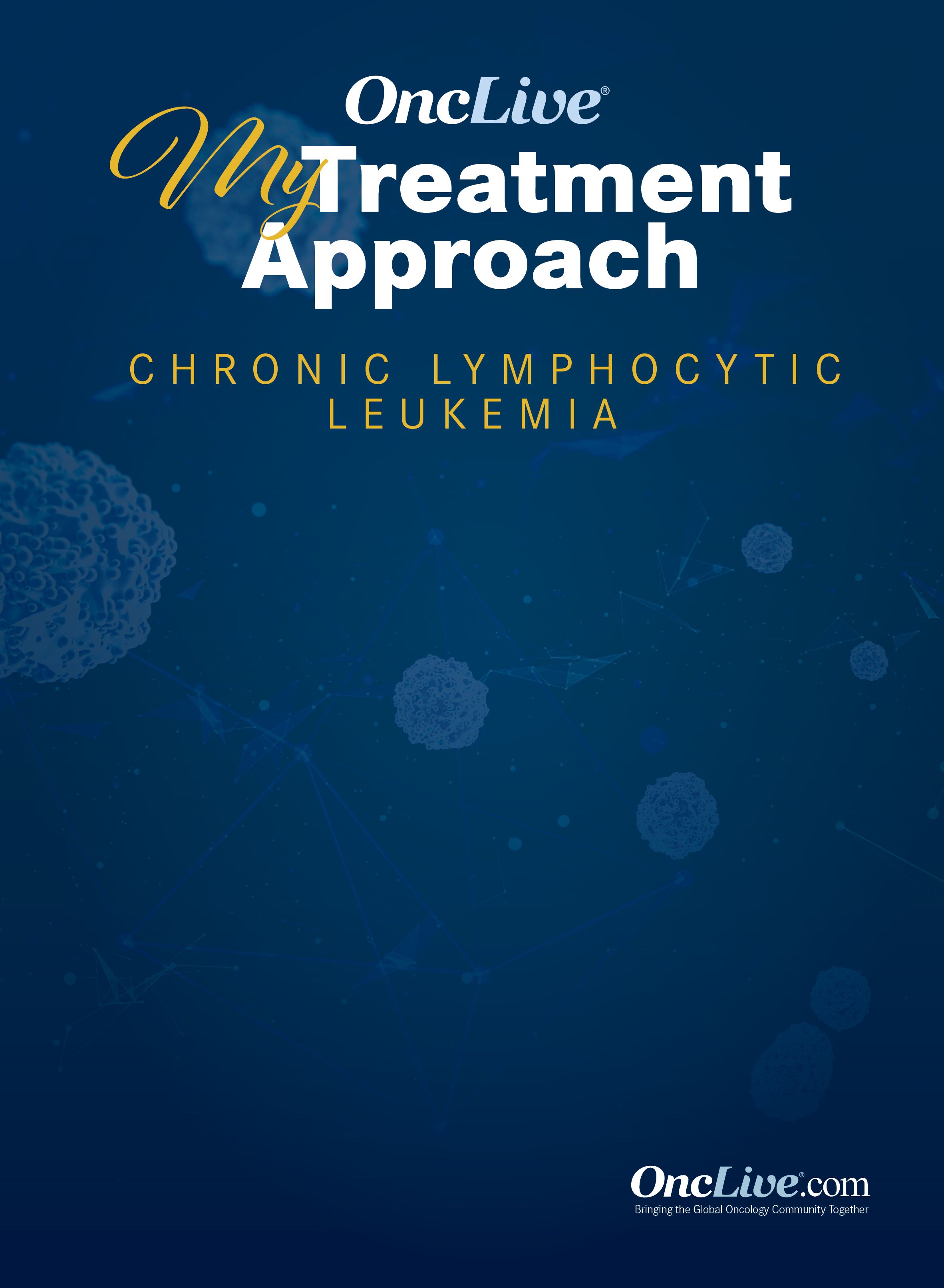Publication
Article
Supplements and Featured Publications
Novel Agents Capture Attention in Newly Diagnosed CLL/SLL
Author(s):
Matthew Lunning, DO, discussed other key considerations for choosing treatments, continuous vs fixed-duration therapies, and emerging agents for patients with relapsed/ refractory CLL and SLL.
Matthew Lunning, DO

As more novel agent–based combinations emerge in the up-front setting for patients with chronic lymphocytic leukemia (CLL), discussions between BTK inhibitor monotherapy and chemoimmunotherapy could be replaced by those of time-limited treatment with BCL-2 inhibitors and PI3Kδ inhibitors, according to Matthew Lunning, DO.
The first approach is supported by updated findings from the phase 2 CAPTIVATE trial (NCT02910583), which demonstrated that patients with previously untreated CLL/small lymphocytic lymphoma who received a placebo following a fixed-treatment duration of ibrutinib (Imbruvica) plus venetoclax (Venclexta) achieved similar 1-year disease-free survival vs patients who remained on ibrutinib following confirmed undetectable minimal residual disease.
With regard to PI3Kδ inhibitors, the combination of ublituximab and umbralisib showed evidence of synergistic activity in patients with CLL compared with standard of care chemoimmunotherapy irrespective of prior treatment, according to results from the phase 3 UNITY-CLL (NCT02612311) trial.
“CLL has become a complicated discussion, not only [when] initiating therapy, but [also when deciding] what to initiate with,” said Lunning. “Then, you need to be strategic, [knowing that] what you choose first may dictate what you do [in the] second- and third-[line] settings.”
Lunning added, “Exciting data are being found in those clinical trials, but we’re going to need months, if not years, of follow-up to know [if] that was the right move—[if] using those [agents] up front is better than sequencing them over time.”
In an interview with OncLive® before the 2020 American Society of Hematology Annual Meeting and Exposition, Lunning, an assistant professor of internal medicine in the Division of Oncology and Hematology at the University of Nebraska Medical Center, further discussed other key considerations for choosing treatments, continuous vs fixed-duration therapies, and emerging agents for patients with relapsed/ refractory CLL and SLL.
OncLive®: What emerging agents under investigation do you find promising?
Lunning: Acalabrutinib [Calquence] has emerged as another BTK inhibitor in the space and has made its way through the relapsed/refractory CLL landscape; it is now in the frontline landscape along with obinutuzumab. One of the differences between ibrutinib and acalabrutinib is that ibrutinib is [taken] once a day and acalabrutinib is [taken] twice a day. There are potentially some differences in adverse effects [AEs].
If patients are intolerant to one BTK inhibitor, can they switch to another? Probably, but you need to look at what the AE was and [whether it] didn’t resolve with dose reduction or it was just nagging enough that you switched to another BTK inhibitor. LOXO-305 is going through clinical trials, and it’s an interesting [agent].
Some PI3K inhibitors are working their way through the CLL pipeline, as are some other monoclonal antibodies. One that comes to mind is ublituximab. There are multiple PI3K inhibitors, such as ME-401 and umbralisib.
There are ongoing CAR [chimeric antigen receptor] T-cell therapy trials; [our institution is participating in] the TRANSCEND CLL 004 study [NCT03331198]. If you talk about where cellular therapy fits into the CLL/SLL landscape, I think it’s in the relapsed/refractory setting [in] patients who have had prior exposure to BTK inhibitors and BCL-2 inhibitors.
Should you give cellular therapy before giving cytotoxic chemotherapy? That is still an unanswered question. If you have a patient with deletion 17p [del (17p)] or TP53-mutated CLL, who has had a short remission duration, would you give cellular therapy before trying to take them to an allogeneic transplant? One of the caveats is that we always say doing an allogeneic transplant in this population makes sense, but you also have to get them into remission and a chemotherapy-sensitive disease state to make the transplant amenable.
How do you approach diagnosing CLL in patients?
Often, patients with CLL are asymptomatic; this diagnosis may [come from] a complete blood count from their primary care provider. We go through the work-up phase of ordering f low cytometry on the peripheral blood to make the diagnosis. Then, you’re looking at what their lymphocyte count is, [as well as] their hemoglobin and platelet count [and] their physical exam, looking for the presence of hepatosplenomegaly or adenopathy of concern.
I like to talk to my patients about what I call the Sesame Street lymph node, which is a lymph node that isn’t growing like the others. We have to keep in mind that one of the prognosis-changing events that can occur in CLL is Richter transformation, which potentially changes treatment in the frontline or relapsed/refractory setting. When patients have progressive cytopenias, they often manifest as anemia, thrombocytopenia, progressive symptomatic splenomegaly, or progressive lymphadenopathy, [any of which could cause] symptoms. That’s a reasonable time point when you have the conversation about which [treatment to use].
Often, if they haven’t had prior cytopenias, they may not have had a bone marrow biopsy. I do [perform] bone marrow biopsies often before starting frontline therapy; I do CT scans if I’m considering using venetoclax up front. Often, [I’ll use] venetoclax [Venclexta] and obinutuzumab [Gazyva] up front because I want to know not only the lymphocyte burden at the time of the initiation of that therapy but also the nodal burden. [This is because] it does likely affect their risk of undergoing tumor lysis with the initiation or the dose ramp required with venetoclax. I’m also looking at creatinine clearance and what their other comorbidities are.
What disease characteristics or patient comorbidities should be examined prior to choosing a frontline treatment?
I’m also looking at other disease-based characteristics that may factor into why I would choose one agent over another. It comes down to age and comorbidities. I [also] look at mutational status; that means [determining] if the patient is IGHV mutated or unmutated. Also, the karyotype status is [important]; having a complex karyotype often portends a potentially poor prognosis [in] CLL and SLL. [I recommend] doing karyotyping in FISH [fluorescence in situ hybridization] to look for del(17p) and a TP53 mutation. If the patient does have a TP53 mutation, I would choose a BTK inhibitor as a first-line therapy in that patient. I would likely choose ibrutinib [Imbruvica] because it has the longest follow-up in that scenario, both in the relapsed/ refractory and frontline settings.
Then, it comes down to the conversation with the patient. If they’re young and they’re fit and [if] they’re IGHV mutated, that determines whether or not you proceed with chemoimmunotherapy. The combination I often use is f ludarabine, cyclophosphamide, and rituximab [Rituxan; FCR]. Patients have experienced long durability [of responses] receiving FCR; it may be curative in a select population.
One of the downsides of FCR is that you’re often treating patients [who have] developed cytopenias. They complete as many cycles as their bone marrow will allow, but they’re often left with some mild cytopenias. If they require second-line therapy, [their choices] become narrowed if they’re already cytopenic after the end of their first-line therapy.
There’s also the question of continuous therapy vs fixedduration therapy. Where does bendamustine/rituximab fit into the tumor landscape? Some have argued [it doesn’t fit] at all, or it does very late [in the disease course], after BTK and BCL-2 inhibitors. However, some individuals may want a chemoimmunotherapy regimen for 6 months, with the potential for time off from therapy.
Some venetoclax regimens are time limited; we’re getting into having that conversation in clinical trials. We’re putting novel therapies together in a time-limited fashion and looking at minimal residual disease negativity as a time point [when we may be able to have them] come off therapy or continue for a little bit longer, or continue on [another regimen] as we start to move into the clinical trial realm.
By the time you’re talking about treatment for your patient, you’ve often achieved a rapport with them and their family. You’re trying to drill down over time to decide whether they’re going to do better on a continuous therapy or whether you’re going to explore the fixed-duration pathway of venetoclax and obinutuzumab. Or, are they an individual who is going to want cytotoxic therapy? Even in the realm of understanding all the randomized data and outcomes that have come in the frontline and relapsed/refractory settings around chemotherapy in that situation, it is still an appealing option [depending on] their mutational status and what their cytogenetics and FISH characteristics are.
I really think that [this involves] shared decision-making, going through the risks and benefits of each therapy, and then really exploring some of the financial aspects of the therapies. You want them to be able to afford the therapies to the point where they aren’t going to [have to stop] after 6 to 12 months. Financial toxicity is also one of the things we may need to consider as we’re discussing treatment options.
How do your discussions with your patients change if they are taking a proton pump inhibitor (PPI)?
It doesn’t affect my choice of therapy. It just changes the discussion that I have with the patient, because you want to ensure that they are taking it as directed based upon the investigator brochure in regard to the timing of when they take their PPI. Typically, we’re discussing acalabrutinib when we’re talking about this. Also, it opens the door for a conversation about whether they still need their PPI or their antacid medicine. These are medicines that you can now buy over the counter. Maybe patients say they don’t like taking another medicine. If that other medicine is a medicine against their CLL, [maybe we can have a conversation about] substituting out a medicine that they may not need, like a PPI or H2 blocker.
This is because it just becomes a medicine that’s in their pillbox, when it was only meant to be given for a prespecified amount of time, and they just continued it because they had access to it. This comes back to internal medicine and [talking about] medicines that are necessary and medicines that are just there because [patients may] take them for a long period of time. It’s an opportunity for medication reconciliation. As you’re starting a new medicine, you have to be cognizant of medicines that may interact, but you also can be cognizant that there may be medicines that may not be necessary.
Would you like to mention anything else regarding your approach to treating patients with CLL?
In the relapsed/refractory setting, it is really predicated on when and what they received last and what [impact that prior therapy had on the patient]. That’s going to be part of the discussion. You can monitor some patients who are otherwise asymptomatic, [where] you still see their disease coming back, but you should be monitoring the velocity or change, how they’re feeling, and whether or not they truly need therapy when the disease is [first] seen vs just starting therapy because you see that their actual lymphocyte counts are going up. The last thing is to always be mindful of the transformation events in this population, because that could potentially be a significant prognosis-changing event, but certainly, it is almost always a therapeutic-changing event.
Reference
Jondreville L, Krzisch D, Chapiro E, et al. The complex karyotype and chronic lymphocytic leukemia: prognostic value and diagnostic recommendations. American J Hem. 2020;95(11):1361-1367. doi:10.1002/ajh.25956









